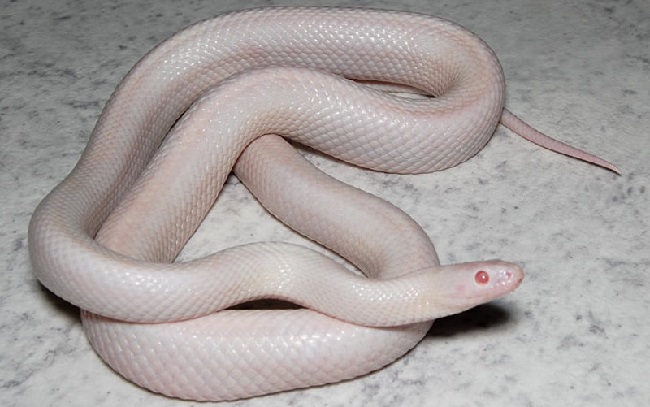The CornSnake, a popular pet among reptile enthusiasts, comes in an array of beautiful colors and patterns, with one of the most striking being the White CornSnake.
Known for their easy-going nature and simple care requirements, they make a great choice for both beginner and experienced snake keepers.
This comprehensive guide will delve into the unique traits, history, dietary preferences, and care needs of the White CornSnake.

Traits of the White CornSnake
Here are some traits of white CornSnakes:
Read Also:
Appearance and Size
White CornSnakes, also known as Leucistic CornSnakes, are known for their brilliant white scales that cover their entire body.
Their eyes, which can range from dark, almost black to deep ruby red, create a beautiful contrast with their bright white scales. They typically grow between 3-5 feet in length, with males being slightly smaller than females.
Behavior and Temperament
CornSnakes, including the white variety, are generally docile and easy to handle. They are nocturnal creatures and are most active during the dawn and dusk.
The History of the White CornSnake
The history of the White CornSnake is tied to the overall history of the CornSnake species. Native to North America, CornSnakes have been popular in the pet trade since the late 20th century due to their manageable size and good-natured disposition.
The White CornSnake is a result of selective breeding processes designed to highlight the leucism trait, leading to its characteristic all-white appearance.
Dietary Needs of the White CornSnake
Like all CornSnakes, the White CornSnake is a carnivore. In the wild, they eat a diet consisting of small rodents, birds, and bird eggs.
In captivity, their diet primarily consists of pre-killed or thawed mice, which should be appropriately sized according to the snake’s size. Feedings typically occur once every 7-10 days, depending on the snake’s age and size.
Caring for Your White CornSnake
Here are some caring tips for whitesnake corn:
Housing
White CornSnakes don’t require elaborate housing. A secure enclosure, like a vivarium or terrarium, with enough room for them to move around is crucial.
The enclosure should have a hot side, where the temperature is about 85 degrees Fahrenheit, and a cool side, with a temperature around 70-75 degrees Fahrenheit.
Enrichment
Include hiding spots and climbing opportunities in the enclosure to mimic their natural environment and encourage natural behaviors.
Handling
White CornSnakes are known for their gentle nature, making them excellent pets for handling. However, it is important to give your snake time to acclimate to its new surroundings before handling.
Breeding White CornSnakes
White CornSnakes are bred from parents carrying the recessive gene for leucism. Breeding these snakes is an intriguing process and one that many snake enthusiasts find incredibly rewarding.
Remember that the breeding process should only be undertaken with a thorough understanding of the snakes’ requirements and potential risks involved.
Choosing the Right Pair
Breeding white CornSnakes successfully requires choosing a compatible pair. Both snakes should be healthy, mature (usually at least three years old), and ideally, have the leucistic gene to increase the likelihood of white offspring.
Breeding Process
The process involves introducing the female to the male’s enclosure during the breeding season, typically in the spring. After successful breeding, the female will lay eggs after about a month.
These eggs should be incubated at 78-82 degrees Fahrenheit until they hatch after about two months.
Health Issues in White CornSnakes
Like any pet, White CornSnakes can encounter health problems. Early detection can lead to more successful treatments.
Respiratory Infections
Signs include wheezing, loss of appetite, and mucus around the mouth and nostrils. Maintain proper temperature and humidity in the enclosure to prevent this.
Skin Conditions
Improper shedding and mites are common skin conditions. Regular checks and proper enclosure conditions can help prevent these.
White CornSnake vs. Other CornSnake Morphs
White CornSnakes are just one of the many CornSnake morphs available in the pet trade. Other popular morphs include the Snow CornSnake, Albino CornSnake, and Black CornSnake.
While each morph has its own unique beauty, the White CornSnake stands out for its uniform, ghostly white coloration.
The Lifespan of a White CornSnake
With proper care, White CornSnakes can live up to 20 years in captivity, making them a long-term commitment. Their lifespan is one of the factors that makes them such appealing pets, as owners can develop a deep, long-lasting bond with these animals.
Read Also:
Conclusion
White CornSnakes, with their striking appearance and docile nature, make fantastic pets for those looking to enter the world of reptile keeping.
By understanding their traits, history, dietary needs, and care requirements, you can ensure your White CornSnake leads a healthy and content life.
Always remember, like all pets, White CornSnakes require commitment, attention, and respect to thrive in a captive environment.
























